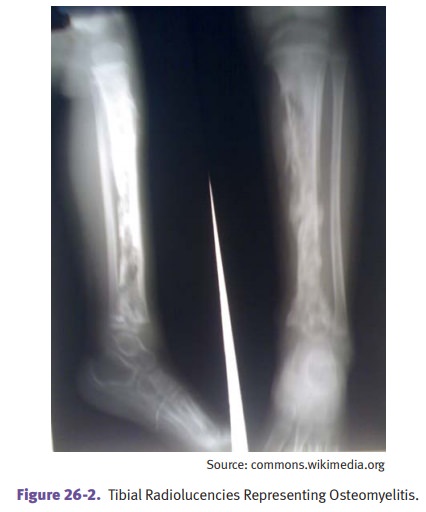Chapter: Pathology: Bone Pathology
Osteomyelitis
OSTEOMYELITIS
Pyogenic osteomyelitis is bone inflammation due to
bacterial infection. The most common route of infection is hematogenous spread (leading to seeding
of bone after bacteremia); this type of spread often affects the metaphysis.
Other routes of spread include direct inoculation (e.g., trauma) and spread
from an adjacent site of infection (e.g., prosthetic joint).
The most common infecting
organism is S. aureus ; other
important pathogens include E. coli,
streptococci, gonococci, H. influenzae,
Salmonella (common in sickle cell
disease), and Pseudomonas (common in
IV drug abusers and diabetics).
Clinically, osteomyelitis is
characterized by fever and leukocytosis; and localized pain, erythema, and
swelling. X-ray studies may be normal for up to 2 weeks, and then initially
show periosteal elevation followed by a possible lytic focus with sur-rounding
sclerosis. MRI and nuclear medicine studies are more sensitive and specific.
Microscopic examination shows
suppurative inflammation. Vascular insufficiency can lead to ischemic necrosis
of bone; a sequestrum is an area of necrotic bone, while an involucrum is the
new bone formation that surrounds the sequestrum. The diagnosis is established
with blood cultures or with bone biopsy and culture.
Patients are treated with
antibiotics and some may require surgical drainage. Com-plications include
fracture, intraosseous (Brodie) abscess, secondary amyloidosis, sinus tract
formation, squamous cell carcinoma of the skin at the site of a persistent
draining sinus tract, and, rarely, osteogenic sarcoma.

Tuberculous osteomyelitis is seen in 1% of cases of TB. It presents with
pain or tenderness, fever, night sweats, and weight loss. Biopsy shows
caseating granulo-mas with extensive destruction of the bones. Common sites of
involvement include thoracic and lumbar vertebrae (“Pott disease”).
Complications include vertebral compression fracture, psoas abscesses, and
secondary amyloidosis.
Related Topics